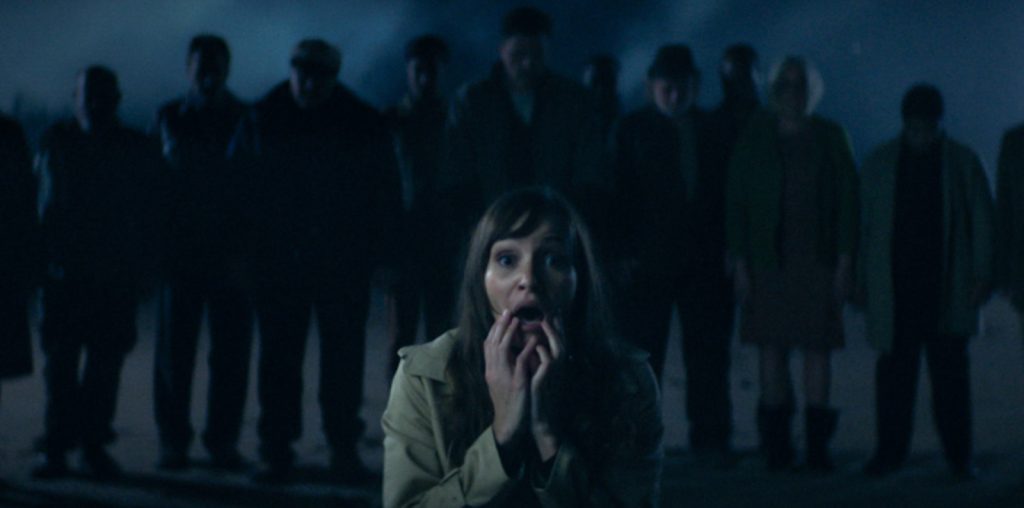
BOOTLEG FILES 425: “The Magic Voyage of Sinbad” (1962 Americanized version of the 1952 Soviet film “Sadko”).
LAST SEEN: The entire film is on YouTube.
AMERICAN HOME VIDEO: On various public domain labels and as part of the “Mystery Science Theater 3000” collection.
REASON FOR BOOTLEG STATUS: A public domain title.
CHANCES OF SEEING A COMMERCIAL DVD RELEASE: Not in its Americanized version, though the Soviet original deserves to be seen.
Fifty years ago, American moviegoers that found themselves in cinemas showing “The Magic Voyage of Sinbad” might have been very confused at what they were watching. Although the film’s title suggested an adaptation of the popular tales of the Persian adventurer Sinbad the Sailor, the actor playing Sinbad had blonde hair, blue eyes and fair skin – not exactly the physical traits one associates with Persian mariners.
Furthermore, Sinbad’s hometown included a church topped with gold domes and people wearing fur-lined coats – again, qualities that one rarely associates with the kingdoms around the Arabian Sea. Even worse, the actors in the film had the peculiar habit of speaking English without synchronizing their lips movements to their dialogue. And if anyone bothered to scan the opening credits, the presence of “Rimsky-Korsakov” as the source of the musical score might seem a bit esoteric – especially since the film was aimed at the kiddie audience.
The secret to these mysterious problems was fairly simple: “The Magic Voyage of Sinbad” has nothing to do with Sinbad. Instead, it was an Americanized version of the award-winning 1952 Soviet film “Sadko,” which was adapted from the Rimsky-Korsakov operatic interpretation of the classic Russian folk tale. The real magic of “The Magic Voyage of Sinbad” was the fact this bizarre charade was ever pulled off without being questioned.
“Sadko” was one of the epic productions of the post-World War II Soviet film industry. Aleksandr Ptushko, the director behind “The New Gulliver” and “The Stone Flower” (the first color feature shot in the USSR), helmed this lavish endeavor, which follows the 17th century sailor Sadko in a raucous journey from the port of Novgorod to Scandinavia, India, Egypt and an undersea kingdom. Sadko searches for the manifestation of happiness – which he believes to be a mysterious bird. However, Sadko’s long journey teaches him that happiness is not to be found in the far corners of the world – it could actually be found at home. (Hmmm, I wonder if Sadko had a kid sister living in Kansas.)
Ptushko’s film was an opulent treat, with elaborate sets and costumes and the glorious Rimsky-Korsakov music. Some of the special effects were quite startling, most notably the half-human/half-avian Phoenix. Other special effects were intentionally campy, most notably the zany catfish sidekick to the undersea king. The film was very popular with Russian audiences and it even found admirers on the far side of the Iron Curtain: the film won the prestigious Silver Lion Award at the 1953 Venice Film Festival.
“Sadko” played briefly in a New York art house cinema in 1953. The New York Times praised the film, noting that its “huge cast, headed by Serge Stolyarov, enacts an almost incredibly picturesque odyssey in imaginative, eye-popping settings, lushly underscored by the sound track, that alone are worth the admission price.” However, the Cold War environment of the early 1950s did not encourage Americans to seek out Soviet films, and few people on this side of the Atlantic were willing to pay to see a film from the Commie movie industry.
By the early 1960s, producer Roger Corman was on the prowl for films that he could cheaply acquire and release through his Filmgroup distribution company. Recognizing the versatility of the Soviet film industry, Corman purchased the U.S. rights to a number of Soviet productions. But rather than present these films in subtitled versions for art house audiences, Corman had the films dubbed into English. In some cases, the screenplays were completely rewritten.
With “The Magic Voyage of Sinbad,” Corman tapped a young Francis Ford Coppola to come up with a new script. Fearful that Americans would reject a film based on Russian folk tale – and hoping that audiences would mistakenly think this was a sequel to the popular 1958 fantasy “The 7th Voyage of Sinbad” – Coppola turned Sadko into Sinbad, with the port of Novgorod becoming “Covosan.” The film also placed Anglicized phony names in the credits, with Ptuschko becoming “Alfred Pasco” and the Soviet state-run Mosfilm production company renamed “Moss Film.”
Furthermore, several Russian-language songs from the soundtrack could not be easily redubbed, so they were abruptly cut from the film. To make sense of the effort, a new voiceover narration was added.
The resulting production, quite frankly, was a mess. There are clearly two films going on here: a vigorous, inventive Soviet visual presentation and a stodgy, badly conceived English-language version tacked on the soundtrack. Sinbad’s colorless English voice does not match the stunning physical force that Serge Stolyarov brings to the role, and the Rimsky-Korsakov music is steamrolled beneath the film’s excessive narration. One song that survived the Americanized editing was credited to “John Smith” and provides such inane lyrics as “Alone my soul must always be / Is happiness beyond the sea? / Or does it hide its shining fare, / In dark caverns waiting there?”
“The Magic Voyage of Sinbad” was dumped in the kiddie matinee circuit – and in his rush to get his film into release, Corman neglected to copyright the production. As a result, it has circulated for years as a public domain title, and this enabled the producers of “Mystery Science Theater 3000” to pluck the film for inclusion in a 1992 episode. The film was showered with the usual brand of snarky wisecracks (including random references to Sam Giancana, Brad Garrett and the Ozark Mountain Daredevils), but Joel and the bots never bothered to pause from their putdowns and identify the film’s distinguished background.
“The Magic Voyage of Sinbad” has been a staple of public domain video labels for years. However, the print that is in circulation looks like a second or third generation dupe – viewing it hurts both the eyes and the mind. Coppola, of course, went on to write more interesting work, while Corman atoned for his sins years later by offering a masterwork of Soviet filmmaking – Akira Kurosawa’s Oscar-winning “Dersu Uzala” – in U.S. theatrical release in its original Russian-language version.
As for the original film, “Sadko” is still copyright protected and was restored in 2005. Thanks to this restoration, the film’s brilliant color cinematography is truly remarkable – and it stands in vibrant contrast to the faded hues of the P.D. junk version. Unfortunately, no U.S. DVD label has released “Sadko,” which can only be seen in a Russian DVD import or in a multi-part installment on YouTube. This film gem remains virtually unknown to American audiences – and it would take real magic (not the cheapo Corman variety) to introduce contemporary viewers to the distinctive charms of “Sadko.”
IMPORTANT NOTICE: The unauthorized duplication and distribution of copyright-protected material, either for crass commercial purposes or profit-free s***s and giggles, is not something that the entertainment industry appreciates. On occasion, law enforcement personnel boost their arrest quotas by collaring cheery cinephiles engaged in such activities. So if you are going to copy and distribute bootleg material, a word to the wise: don’t get caught. Oddly, the purchase and ownership of bootleg DVDs is perfectly legal. Go figure!


For years, this film was in a syndication package from Lorimar/Lorimar-Telepictures in Black & White and only surfaced in color in the early 1990’s thanks to SINISTER CINEMA